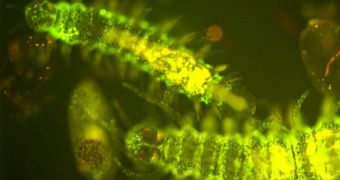Ocean experts attribute the bright green glow that can be seen in the world's oceans at times to the bioluminescence that certain types of worms give up during their mating rituals. That is to say, extremely large numbers of fireworms meet in the same spot and conduct a series of mating rituals, displaying their bright colors in hopes of attracting the right mates. In addition, recent investigation also seems to hint at the fact that the small creatures also use their “headlights” in order to defend themselves from intruders or competitors.
Dimitri Deheyn, a marine biologist from the Scripps Institution of Oceanography (SIO) and colleague Michael Latz have published the results of their latest study in the winter 2009 issue of the journal Invertebrate Biology and have thus brought the goal of understanding exactly how this light is being produced a bit closer. Scientists around the world are actually trying to identify the molecular basis of the luminescence, in that they seek to find out precisely what chemical and biological properties endow the small creatures with this magnificent ability.
“This is another step toward understanding the biology of the bioluminescence in fireworms, and it also brings us closer to isolating the protein that produces the light. If we understand how it is possible to keep light so stable for such a long time, it would provide opportunities to use that protein or reaction in biomedical, bioengineering and other fields – the same way other proteins have been used,” Deheyn says of the Odontosyllis phosphorea worms.
These animals can be mostly found in tropical and sub-tropical shallow coastal waters, and live at the bottom of the sea, where they spend most of their lives. Females are responsible for releasing the green, glowing mucus, which is secreted into the water just as the creatures drop their eggs. In addition to catching the eye of human sailors, the green substance also attracts the males of the species, who then release their own eggs into the greenish cloud.

 14 DAY TRIAL //
14 DAY TRIAL //